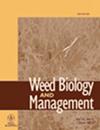南疆塔里木河地区棉花田杂草调查
IF 1.5
4区 农林科学
Q3 AGRONOMY
引用次数: 0
摘要
本研究旨在调查塔里木河地区棉田杂草的侵扰情况。在这些棉田中发现了 17 科 49 种杂草,其中 24 种为一年生杂草。塔里木河流域棉田中最主要的 8 种杂草包括:Chenopodium glaucum、Solanum nigrum、Chenopodium album、Chenopodium hybridum、Bolboschoenus planiculmis、Sonchus arvensis、Phragmites australis 和 Mulgedium tataricum。阿克苏河支流区、叶尔羌河支流区和塔里木河上下游的杂草种类分别达到 29 种、36 种、35 种和 33 种。各流域广泛分布着 20 个物种。阿克苏河流域和塔里木河上游棉田的主要杂草为黑麦草和禾本科杂草,叶尔羌河流域棉田的主要杂草为禾本科杂草和杂草,塔里木河下游棉田的主要杂草为禾本科杂草和禾本科杂草。值得注意的是,调查中常见的 20 个物种包括 C. glaucum、S. nigrum、C. album、C. hybridum、B. planiculmis、S. arvensis、P. australis、M. tataricum 等,如果不加以适当控制,可能会对地区作物生产构成严重挑战。因此,每块棉田都应因地制宜地采用合适的除草方案,并加强杂草监测,特别是杂草分布区的特点。本文章由计算机程序翻译,如有差异,请以英文原文为准。
Weed survey on cotton (Gossypium hirsutum) fields in the Tarim River region of southern Xinjiang
This study was conducted to investigate weed infestations of cotton (Gossypium hirsutum) fields in the region of Tarim River. Forty-nine species among 17 families were identified in these cotton fields, and 24 of them were annuals. The eight dominant weed species in the cotton fields of Tarim River basin included Chenopodium glaucum, Solanum nigrum, Chenopodium album, Chenopodium hybridum, Bolboschoenus planiculmis, Sonchus arvensis, Phragmites australis, and Mulgedium tataricum. The number of weed species in the Aksu River tributary area, Yeerqiang River tributary area, and the upper and lower reaches of the Tarim River reached 29, 36, 35, and 33, respectively. Twenty species were found widely distributed among each basin. The dominant weeds in the cotton fields in the Aksu River basin and upper reaches of the Tarim River were S. nigrum and C. glaucum, those in the cotton fields in the Yarkand River basin included C. album and C. hybridum, and those in the cotton fields in the lower reaches of the Tarim River were C. glaucum and C. album. Notably the 20 common surveyed species of C. glaucum, S. nigrum, C. album, C. hybridum, B. planiculmis, S. arvensis, P. australis, M. tataricum, and others, could pose a serious challenge to regional crop production if not adequately controlled. As such, each cotton field should adopt a suitable weeding scheme with strengthened weed monitoring according to the local conditions, especially the weed distribution area characteristics.
求助全文
通过发布文献求助,成功后即可免费获取论文全文。
去求助
来源期刊

Weed Biology and Management
农林科学-农艺学
CiteScore
2.70
自引率
0.00%
发文量
13
审稿时长
>36 weeks
期刊介绍:
Weed Biology and Management is an international journal, published four times per year. The journal accepts contributions in the form of original research and review articles in all aspects of weed science. Contributions from weed scientists in the Asia–Pacific region are particularly welcomed.
The content of the contributions may relate to weed taxonomy, ecology and physiology, weed management and control methodologies, herbicide behaviors in plants, soils and environment, utilization of weeds and other aspects of weed science. All contributions must be of sufficient quality to extend our knowledge in weed science.
 求助内容:
求助内容: 应助结果提醒方式:
应助结果提醒方式:


